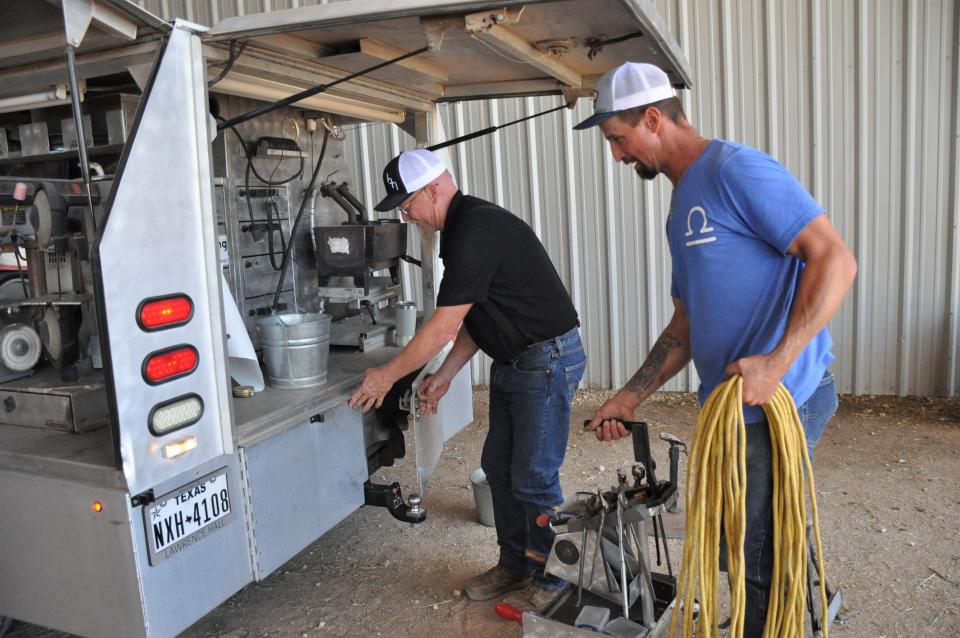Horses need new shoes: Farriers on hand for Texas high school rodeo finals
Sometimes, horses need laces to go with their shoes.
Farriers Hoyt Foster of Abilene and Kirk “Smiley” Roda of Baird on Monday were tending to some of the hooves of the performance horses at the 2022 Texas High School State Finals Rodeo.
Since the middle of last week, about 670 of the best boys and girls in rodeo and their families have circled horse trailers, RVs and trucks around the Taylor County Expo Center for the annual event.
Competition categories include cutting, bareback, steer wrestling, barrel racing, breakaway roping, calf roping, saddle bronc, goat tying, team roping, pole bending and bull riding.
More: Texas high school rodeo finals begin Thursday at Abilene's Taylor County Expo Center
Two daily sessions of preliminaries at 8 a.m. and 2 p.m. began Monday at Taylor Telecom Arena and continue through Friday. There also are about 40 vendors showcasing clothing, jewelry, boots, tack and more.
Thursday is Family Day, which includes a concession stand special of a hot dog and soft drink for $3 and the McCoy’s Mutton Busting Competition following the 2 p.m. preliminaries.
The top 15 performers in each category will compete in the finals at 10 a.m. Saturday, and the top four finishers quality for the National High School Rodeo Finals in Gillette, Wyoming on July 17-23.
Tickets for preliminaries through Friday are $7 for adults and $4 for children. Entrance to the Saturday finals costs $8 for adults and $5 for students.
Caring for hooves

At the high school rodeo finals, Foster and Rosa were available to trim the horses' hooves and affix new shoes if necessary.
"We put shoes on for three reasons – for protection and performance and physiology," Foster said.
In that last category, "if they've got something wrong with them, we can try to correct it through our horse shoes," he said.
Examples of problems that can be addressed with horse shoes include crooked limbs, bad hoof walls and ligament stresses.
"It takes about one year for a whole hoof to grow from the top of the hairline out to the bottom," Foster said.
Horseshoes are not all created alike. They can be grooved or smooth, firm or padded, flat or wedged, or have other unique features. Which is best suited for the horse depends on the activity and other factors.
Foster is a fourth generation farrier who tends to horses within about a 40-mile radius of Abilene. He also works once a week at the West Texas Equine Clinic.
The farrier hammers of his father, grandfather and great-grandfather are retired and at Foster's home. While his own hammer remains essential, his work truck is a mobile shop outfitted with advanced tools and supplies.
There's a propane tank to fuel a small forge to heat and shape the shoes and burned onto the hoof. A welding machine, band saw and other power tools come in handy too.
"The industry's come a long way in what's available to help horses but, it's still a lot of work," Foster said.
Laces for horse hooves
One of the favorite parts of farrier work is helping "horses that are crippled get sound again," Foster said.
For a recent horse with a cracked hoof, Foster used a Dremel rotary tool to clear out the crack and drilled small holes on the sides of the gap. He worked a fine, metal cable suture through the holes to lace the split foot together.
The description of such invasive techniques sounds painful, but it's not, Foster said. Hooves are made of the same substance as human fingernails, and similarly do not sense pain.
"I explain it like this. You know, in the wintertime, your head gets cold, but your hair doesn't," Foster said. "Horses' hooves are made up of keratin just like your hair, so it doesn't transfer heat or cold. So that's why when we smoke those shoes on, they don't feel it, because it doesn't transfer the heat."
His most interesting task was helping a lame horse with cancer inside the hoof capsule. Foster used a Dremel tool to reach the cancer area, which could then be cleaned. He then fashioned a door hinge to attach to the top of the hoof and cover the hole.
The design, which came to him during the night, enabled those caring for the horse to open the hinge, doctor the foot and close it, Foster said.
Because of the cancer, the horse "was really, really crippled. And right after we removed it, it went back to walking pretty sound," Foster said.
He prefers to work on horses, but has aided other hoofed creatures on occasion.
"I built a toe with epoxy for a show lamb that got its toe cut off," Foster said.
Those unique challenges show that the most important farrier tools can't be stocked on a work truck.
One is creativity, Roda said. The other is an understanding of the horses.
"You have to care, and you have to have a feel for horses. Not just anybody can reach down there and pick a foot up. You have to have a good feel for horses," Roda said.
Laura Gutschke is a general assignment reporter and food columnist and manages online content for the Reporter-News. If you appreciate locally driven news, you can support local journalists with a digital subscription to ReporterNews.com.
This article originally appeared on Abilene Reporter-News: Farriers help horses be sure-footed at Texas high school rodeo finals

